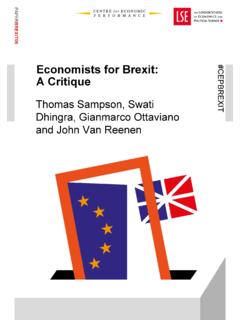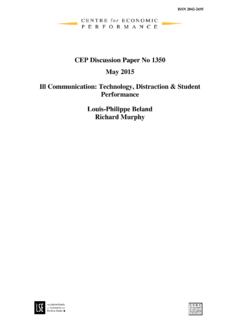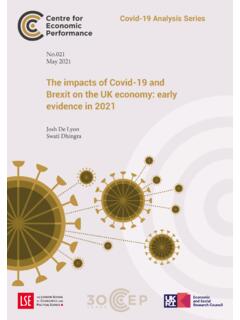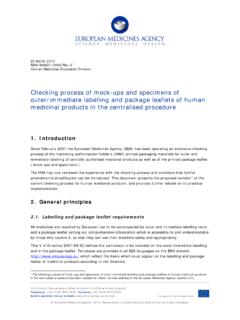Transcription of Brexit and the Impact of Immigration on the UK
1 Brexit and the Impact of Immigration on the UK Jonathan Wadsworth,Swati Dhingra, Gianmarco Ottaviano and John Van Reenen#CEPBREXITPAPERBREXIT05 CEP Brexit ANALYSIS NO. 5 Brexit and the Impact of Immigration on the UK Between 1995 and 2015, the number of immigrants from other European Union (EU)countries living in the UK tripled from million to million. In 2015, EU netimmigration to the UK was 172,000, only just below the figure of 191,000 for non-EUimmigrants. The big increase in EU Immigration occurred after the A8 East European countriesjoined in 2004. In 2015 29% of EU immigrants were Polish. EU immigrants are more educated, younger, more likely to be in work and less likely toclaim benefits than the UK-born.
2 About 44% have some form of higher educationcompared with only 23% of the UK-born. About a third of EU immigrants live in London,compared with only 11% of the UK-born. Many people are concerned that Immigration reduces the pay and job chances of the UK-born due to more competition for jobs. But immigrants consume goods and services andthis increased demand helps to create more employment opportunities. Immigrants alsomight have skills that complement UK-born workers. So we need empirical evidence tosettle the issue of whether the economic Impact of Immigration is negative or positive forthe UK-born. New evidence in this Report shows that the areas of the UK with large increases in EUimmigration did not suffer greater falls in the jobs and pay of UK-born workers.
3 The bigfalls in wages after 2008 are due to the global financial crisis and a weak economicrecovery, not to Immigration . There is also little effect of EU Immigration on inequality through reducing the pay andjobs of less skilled UK workers. Changes in wages and joblessness for less educated UK-born workers show little correlation with changes in EU Immigration . EU immigrants pay more in taxes than they take out in welfare and the use of publicservices. They therefore help reduce the budget deficit. Immigrants do not have a negativeeffect on local services such as crime, education, health, or social housing European countries with access to the Single Market must allow free movement of EUcitizens whether in the EU (like the UK) or outside it (like Norway and Switzerland).
4 The refugee crisis has nothing to do with EU membership. Refugees admitted to Germanyhave no right to live in the UK. The UK is not in the Schengen passport-free travelagreement so there are border checks on for Economic Performance London School of Economics and Political Science Houghton Street, London WC2A 2AE, UK Tel: +44 (0)20 7955 7673 Email: Web: CEP on Twitter: @CEP_LSED isclaimer:The Centre for Economic Performance (CEP) is a politically independent Research Centre at the London School of Economics. The CEP has no institutional views, only those of its individual researchers. Professor John Van Reenen who joined the CEP as Director in 2003, did not (and does not) support joining the s Brexit work is funded by the UK Economic and Social Research Council.
5 As a whole the CEP, receives less than 5% of its funding from the European Union. The EU funding is from the European Research Council for academic projects and not for general funding or Introduction In the referendum debate about the UK s membership of the European Union (EU), a major argument of the Leave campaign is that Brexit would allow more control over the flow of immigrants to the UK from the rest of the EU. Many people are concerned that high levels of Immigration may have hurt their jobs, wages and quality of life. Immigration has grown a lot in the last 20 years and a significant fraction of this growth has been from other EU countries, especially after 2004 and the accession of eight East European countries (the A8 ).
6 Between 1995 and 2015, the number of immigrants from other EU countries living in the UK tripled from million to million. The share of EU nationals grew from to of the total population and from to of the working age population (adults aged 16-64). Higher Immigration has increased overall national income (more workers will generate more GDP) and has benefited the immigrants who have come to the UK since, by and large, they are better off than in their country of origin. But has it been economically harmful to people born in the UK? In this Report, we present a new analysis of the most recent data to examine whether EU Immigration has affected the income prospects of the UK-born. EU Immigration to the UK Figure 1: Net Immigration to the UK, 1991-2015 Source: CEP analysis of ONS (2016) Net Immigration is the difference between the number of people entering the UK and the number of people leaving.
7 Figure 1 shows how these have increased for EU and non-EU immigrants. When the East European A8 countries1 joined the EU in 2004, Immigration rose1 The A8 countries are the Czech Republic, Estonia, Hungary, Latvia, Lithuania, Poland, Slovakia and Slovenia. 050100150200250yearly flows (thousands)1991199519992003200720112015y earEUNon-EUNet Immigration to UK3 significantly, but it then fell back during the recession after 2007. In the last few years, net inflows have again risen significantly as the economy has recovered. In the year to September 2015, net EU Immigration was 172,000, comprising 257,000 EU nationals arriving and 85,000 leaving. This is only just below the figure of 191,000 net Immigration for non-EU nationals.
8 The best source of data to explore the Impact of Immigration is the Labour Force Survey (LFS). This is because it makes it possible to measure the economic circumstances of people born in the UK and compare them with immigrants from the EU and other countries. The Annex gives more details and compares the LFS with other data sources, such as National Insurance numbers. The conclusions of this report are robust to using other data sources such as NI numbers for migration and the Annual Survey of Hours and Earnings for wages. In 2015, there were around million EU immigrants living in the UK up from million in 1995 - a rise to of the population from Around million of these migrants are aged 16-64 and two million are in EU countries now account for 35% of all immigrants living in the UK.
9 While 29% of EU nationals are Polish and 12% are Irish, the nationalities of other EU immigrants are quite evenly spread across the other 25 countries in the EU (Figure 2). As with other immigrants, there is a greater concentration of EU nationals in London than in the rest of the country (Figure 3). A third of EU nationals live in London compared with only 11% of UK nationals. Figure 2: EU immigrants by nationality, 2015 Source: CEP analysis of Labour Force Survey. 2 The focus is on EU nationals (self-defined) rather than country of birth, since any decision to restrict entry would presumably be based on nationality and not country of birth. 4 Figure 3: Proportion of UK and EU nationals in each region, 2015 Source: CEP analysis of Labour Force Survey.
10 Notes: London is marked in black. This is where immigrants are disproportionately concentrated. EU immigrants are on average more educated than the UK-born (Table 1) almost twice as many of them have some form of higher education (43% compared with 23% UK-born). Only 15% of EU immigrants left school at 16 compared with 44% of the UK-born. Table 1: Education and immigrant status (working age population) 2015 Age finished education UK-Born EU immigrantsA8 immigrants All immigrants High ( 21 or older) 23% 43% 36% 45% Medium (17-20) 33% 42% 55% 36% Low (16 or under) 44% 15% 9% 19% All 100% 100% 100% 100% Source: CEP analysis of Labour Force Survey. Notes: The A8 countries are the Czech Republic, Estonia, Hungary, Latvia, Lithuania, Poland, Slovakia and Slovenia, all of which joined the EU in 2004.











